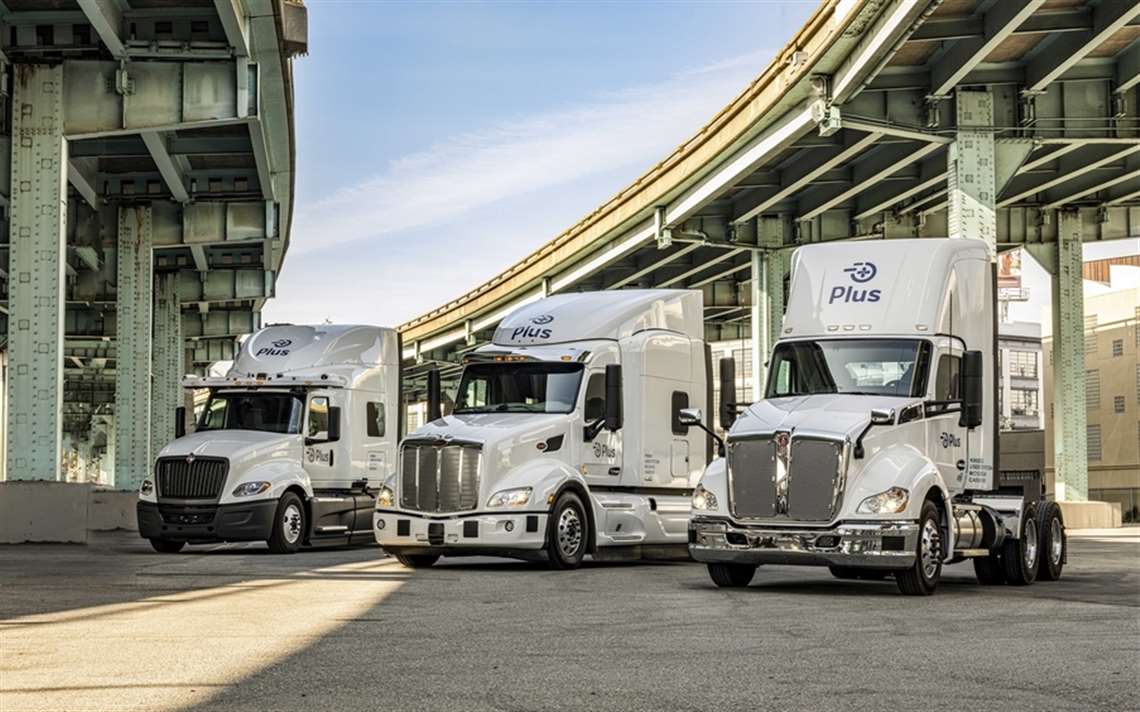Plus Picks BlackBerry Operating System For Self-Driving Trucks
03 December 2020

BlackBerry gets more commercial truck business for its QNX embedded operating system, signs agreement with Amazon Web Services for new automotive data platform.
BlackBerry’s QNX real-time embedded operating system has been selected for the commercial deployment of a new self-driving system for Class 8 trucks. With the announcement, Plus, a Cupertino, Calif., based technology company reportedly becomes the first automated truck developer to use QNX technology for a self-driving system.
Based in Waterloo, Ontario, Canada, BlackBerry Ltd. is perhaps better known to consumers for its smartphones (the company changed its name from Research In Motion to BlackBerry in 2013). However, during last summer it reported that its QNX software was embedded in more than 175 million cars from a variety of manufacturers and brands.
BlackBerry has a broad portfolio of functional safety-certified and secure software including the QNX operating system, development tools and middleware for autonomous and connected vehicles. Original equipment manufacturers (OEMs) and Tier 1s use QNX software in their advanced driver assistance, digital instrument clusters, connectivity modules, handsfree, and infotainment systems.
“The electronic architecture of the vehicle is evolving from being hardware-driven to software-defined,” said John Chen, executive chairman and CEO, BlackBerry.
As part of the agreement with Plus, BlackBerry will license its ISO 26262 ASIL-D safety-certified QNX OS for Safety software solution to Plus, which it said will further strengthen the technology foundation it has built for a safe and secure automated driving system. Based on the QNX Neutrino Real-time Operating System (RTOS), QNX OS for Safety is already used by embedded software developers for mission-critical systems in medical devices, industrial controls, rail, robotics, aerospace and defense.
“Self-driving systems consist of the most complex and powerful software and hardware to go into a Class 8 truck. Every technology choice we make has to contribute to the overall safety and security of heavy-duty trucks integrated with the Plus automated driving system. The operating system is an important foundation for the rest of the system,” said Shawn Kerrigan, COO and co-founder, Plus, Cupertino, Calif. “Our engineering team has done an exceptional job in completing the transition to the industry’s highest standard of safety-certified technology as we move from product development to commercial deployment.”
Founded in 2016, Plus specializes in technology to enable large scale autonomous commercial transport.
A certified automotive operating system is the foundation of a self-driving truck, said BlackBerry, helping manage data flow from sensors to prediction technology and to the actuation that controls the movement. Optimizing the data flow can also help to speed up the image processing, machine learning and other algorithms that are needed for the automated driving system to work.
The transition to the safety-certified QNX OS for Safety, along with other enterprise technology that Plus has adopted, is expected to help the company work more quickly with its OEM and fleet partners with the commercial rollout of its automated driving system.
“BlackBerry QNX provides both commercial and personal autonomous vehicle developers with operating systems that meet the highest safety, reliability and security standards. We are thrilled to support the commercialization of automated trucks and to work with the Plus team to advance the global deployment of its automated trucking system,” said John Wall, senior vice president and co-head of BlackBerry Technology Solutions. “Self-driving trucks will have a revolutionary impact on the logistics industry, and it is exciting to contribute to making that future possible.”

Last year, BlackBerry announced that its QNX technology had been selected by Arrival Ltd. to operate the start-up’s intelligent, autonomous-ready battery-electric commercial vehicles.
Amazon, BlackBerry and IVY
In related news, Amazon Web Services Inc. (AWS), an Amazon.com Inc. company and BlackBerry have announced a multi-year, global agreement to develop and market BlackBerry’s Intelligent Vehicle Data Platform, IVY. It is a scalable, cloud-connected software platform that the company said will allow automakers to provide a consistent and secure way to read vehicle sensor data, normalize it, and create actionable insights from that data both locally in the vehicle and in the cloud. Automakers can use this information to create responsive in-vehicle services that enhance driver and passenger experiences.
According to BlackBerry, IVY addresses a critical data access, collection, and management problem in the automotive industry. Modern cars and trucks are built with thousands of parts from many different suppliers, with each vehicle model comprising a unique set of proprietary hardware and software components. These components, which include an increasing variety of vehicle sensors, produce data in unique and specialized formats. The highly specific skills required to interact with this data, as well as the challenges of accessing it from within contained vehicle subsystems, limit developers’ abilities to innovate quickly and bring new solutions to market.
IVY will solve these challenges, said BlackBerry, by applying machine learning to that data to generate predictive insights and inferences, making it possible for automakers to offer in-vehicle experiences that are highly personalized and able to take action based on those insights. It will build upon the capabilities of QNX for surfacing and normalizing data from automobiles and AWS’s broad portfolio of services, including capabilities for IoT and machine learning.
“AWS and BlackBerry are making it possible for any automaker to continuously reinvent the customer experience and transform vehicles from fixed pieces of technology into systems that can grow and adapt with a user’s needs and preferences,” said Andy Jassy, CEO of AWS. “Through this joint effort with BlackBerry, we will provide automakers with the insights, capabilities, agility, and speed they need to thrive in an increasingly connected world. As automakers seek to race ahead in their digital transformations, BlackBerry IVY empowers them to build their brands and set the standard for connected vehicle services across the automotive industry.”
BlackBerry said the system will enable automakers to compress the timeline to build, deploy, and monetize new in-vehicle applications and connected services across multiple vehicle brands and models. In addition, it will help make it easier for automakers to collaborate with a wider pool of developers to accelerate the creation of new offerings.

Automakers will be able to remotely deploy and update the software from the platform’s Cloud Console (a web interface for managing BlackBerry IVY) to continuously improve the functionality of the system.
“IVY is a platform,” said Vito Giallorenzo, senior vice president, Corporate Development and Strategic Partnerships, BlackBerry, during the company’s Investor Fireside Chat on December 2. “It’s targeted to the entire ecosystem built around automotive, but the primary target customers for us will be the automakers, the OEMs. They are the first adopters we need to secure to in order to guarantee that there is a ubiquitous base of brands and models of cars that will leverage IVY. That will secure the base that will allow the rest of the ecosystem to flourish. But at same time, we’re also talking to several leading Tier 1 and Tier 2 suppliers that are interested in IVY. They have solutions that will benefit from IVY and will be using it. We’re also looking at ways to build the entire ecosystem beyond that, such as application and solution providers.”
AWS is a cloud platform that offers more than 175 services for robotics, machine learning and artificial intelligence (AI), Internet of Things (IoT) and more.
POWER SOURCING GUIDE
The trusted reference and buyer’s guide for 83 years
The original “desktop search engine,” guiding nearly 10,000 users in more than 90 countries it is the primary reference for specifications and details on all the components that go into engine systems.
Visit Now
STAY CONNECTED




Receive the information you need when you need it through our world-leading magazines, newsletters and daily briefings.
CONNECT WITH THE TEAM












